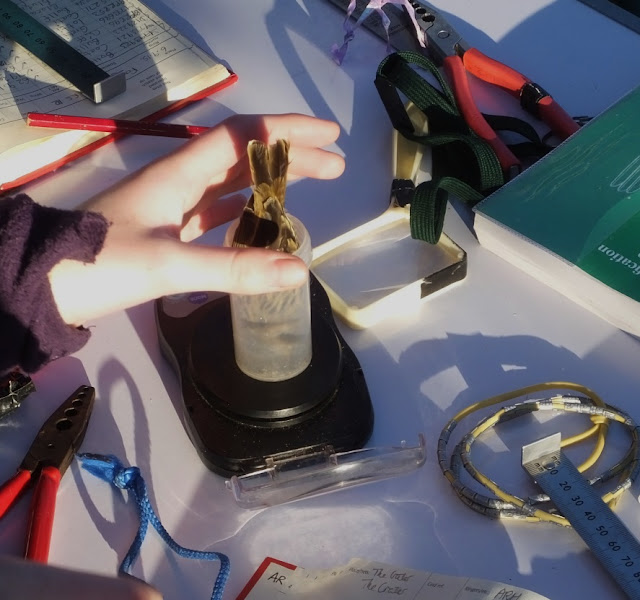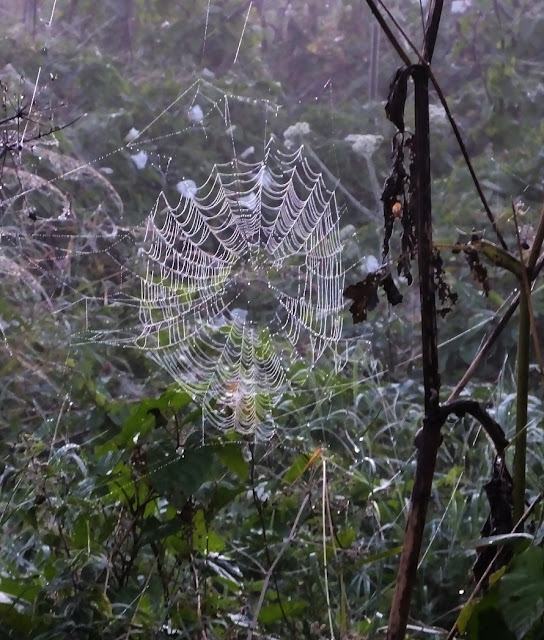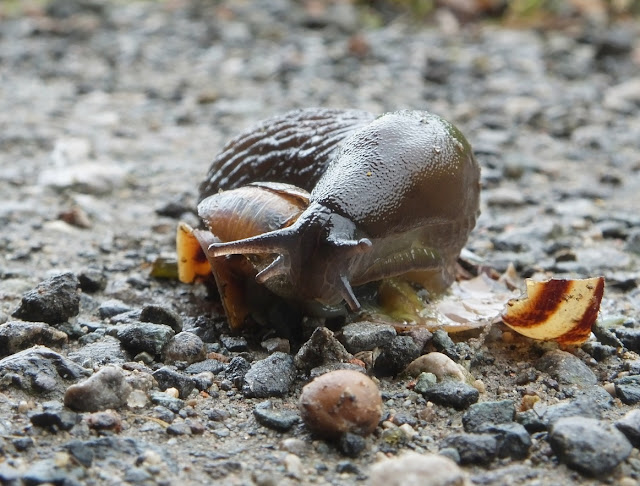The Safari had a minor change of direction on the way to work and
headed the wrong way to meet up with ringer AD who was trialling a new site and
targeting, somewhat coincidentally, Meadow Pipits.
It might have been a new ringing site for him but it’s
somewhere we know well but haven’t visited for a good few months. The tree
planting has come on well this summer looking at the height of many of them
particularly down in the bottom of the dell where a fair proportion of them are
no taller than we are and their tops are beginning to spread into some form of
canopy. The site looked lovely in the early morning mist.
We weren’t sure where AD would be set up and we set off in
the ‘wrong’ direction but soon caught the sound of Meadow Pipit song coming
through the mist away to our left, that could only be an MP3 player as the real
birds don’t sing at this time of year. Sure enough on the far side of the ‘valley’
we could see net poles and a couple of dark figures stood in the corner
chatting.
After a short down then up we saw the net poles and AD processing a bird that had just found the net.
A small number of single Blackbirds worked their way south in fits and starts along the adjacent gardens’ fence-line. Overhead more Meadow Pipits dropped from unseen height when they heard the artificial calls below them. Most were seen to land in the long grass near the nets but a couple alighted on the top wire of the nets, this was going to be a recurring theme. The pipits came through in small flocks several minutes apart for the first hour then tailed off to dribs and drabs but lower down, so low they were visible to us, later on.
After a short down then up we saw the net poles and AD processing a bird that had just found the net.
A small number of single Blackbirds worked their way south in fits and starts along the adjacent gardens’ fence-line. Overhead more Meadow Pipits dropped from unseen height when they heard the artificial calls below them. Most were seen to land in the long grass near the nets but a couple alighted on the top wire of the nets, this was going to be a recurring theme. The pipits came through in small flocks several minutes apart for the first hour then tailed off to dribs and drabs but lower down, so low they were visible to us, later on.
Away in the distance beyond the 'burbs we could see geese dropping in to feed, some could have been Grey Lag Geese or Canada Geese but many will have been recently arrived Pink Footed Geese, further east still there were high skeins of undoubtedly Pink Footed Geese and these may have been fresh in migrants coming down from Scotland.
The Meadow Pipits continued to infuriate by landing on the top wire of the nets and refusing to dive into the pockets when the numerous early morning dog walkers walked past. It was good to see them taking a positive interest in what was happening in their local park. As you would expect but it shouldn't really be so none of them had ever heard of such a common bird as a Meadow Pipit. This really needs to change; if we are to protect the wildlife on this planet and especially in our own little island people need to be aware of what wildlife is around them. We have made a list, for schools' projects, of the 100 most common birds we reckon that 99% of people round here if you did a survey would only be able to identify 4 or 5 correctly - and most of those would be ones they disliked eg Magpie which was mentioned more than once this morning - - that isn't good enough!
A couple of Grey Wagtails passed overhead as did a couple of Pied Wagtails with a lone Goldfinch, don't know where they picked that up from, and the Coal Tit theme continued with three popping out of someones largish garden Sycamore and bumble about looking for their next port of call.
Here's another pic of one of yesterday's Coal Tits - now is it leady/silvery grey enough to be of the continental nominate subspecies rather than a more olivey brown that the britannicus British subspecies are supposed to be??? Wish we hadn't deleted all the other not quite so good ones showing the bird in different positions now, one may have shown some sign of a little raised crest with a bit of luck.
Just about our last bird of the session was a Heron flying east, had it come down the coast and turned inland, or been feeding on the beach while the tide was low?
A couple of Grey Wagtails passed overhead as did a couple of Pied Wagtails with a lone Goldfinch, don't know where they picked that up from, and the Coal Tit theme continued with three popping out of someones largish garden Sycamore and bumble about looking for their next port of call.
Here's another pic of one of yesterday's Coal Tits - now is it leady/silvery grey enough to be of the continental nominate subspecies rather than a more olivey brown that the britannicus British subspecies are supposed to be??? Wish we hadn't deleted all the other not quite so good ones showing the bird in different positions now, one may have shown some sign of a little raised crest with a bit of luck.
Just about our last bird of the session was a Heron flying east, had it come down the coast and turned inland, or been feeding on the beach while the tide was low?
All too soon a couple of hours was up and we had to head off to our proper work.
Before too long it was lunchtime and we could nip out for a look at Patch 2.
The sea was pretty flat and the light good so we were able to revise our Common Scoter count upwards a bit to at least 1500. Also out there was a summer plumaged Red Throated Diver, three Razorbills and a Great Crested Grebe. Half a dozen Swallows went through well out to sea and not much closer in were a couple of bouncy things heading south only a foot or so above the wavelets, most likely Meadow Pipits. A Small Tortoiseshell went quickly south along the top of the seawall - a migrant too?
With the sea being not too exciting we decided to give up early and have a slow mooch around the works garden - we did two laps finding no more Coal Tits and no Yellow Browed Warblers either, they are getting closer with one being found just up the coast a few miles mid-morning. We did see a Red Admiral, a Small White nectaring on Dandelions - have we told you how important this plant is for wildlife especially our pollinating invertebrates? Please don't dig them up or spray them off! - A Silver Y moth took advantage of the flowers on our Tree Mallows - now that is a weed! but the pollinators do seem to like it. The only birds of note was a little increase(?) in Robins with four counted.
So a bit of a different day out on safari today.
Where to next? The boiler sedrvice engineer is coming tomorrow morning so we might have another go at Mipiting with AD or stay at home and wait doing a bit of vis migging in the garden.
In the meantime let us know who's bypassing your outback very effectively
The sea was pretty flat and the light good so we were able to revise our Common Scoter count upwards a bit to at least 1500. Also out there was a summer plumaged Red Throated Diver, three Razorbills and a Great Crested Grebe. Half a dozen Swallows went through well out to sea and not much closer in were a couple of bouncy things heading south only a foot or so above the wavelets, most likely Meadow Pipits. A Small Tortoiseshell went quickly south along the top of the seawall - a migrant too?
With the sea being not too exciting we decided to give up early and have a slow mooch around the works garden - we did two laps finding no more Coal Tits and no Yellow Browed Warblers either, they are getting closer with one being found just up the coast a few miles mid-morning. We did see a Red Admiral, a Small White nectaring on Dandelions - have we told you how important this plant is for wildlife especially our pollinating invertebrates? Please don't dig them up or spray them off! - A Silver Y moth took advantage of the flowers on our Tree Mallows - now that is a weed! but the pollinators do seem to like it. The only birds of note was a little increase(?) in Robins with four counted.
So a bit of a different day out on safari today.
Where to next? The boiler sedrvice engineer is coming tomorrow morning so we might have another go at Mipiting with AD or stay at home and wait doing a bit of vis migging in the garden.
In the meantime let us know who's bypassing your outback very effectively

































































